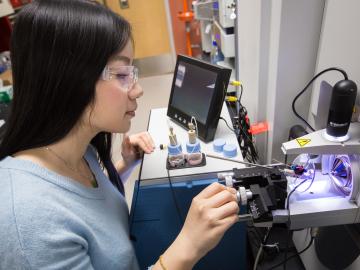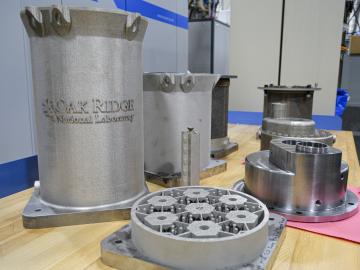
Filter News
Area of Research
- (-) Materials (54)
- (-) Neutron Science (26)
- (-) Nuclear Science and Technology (21)
- Advanced Manufacturing (4)
- Biological Systems (1)
- Biology and Environment (30)
- Building Technologies (1)
- Computational Biology (1)
- Computational Engineering (3)
- Computer Science (13)
- Energy Science (48)
- Fuel Cycle Science and Technology (1)
- Fusion and Fission (11)
- Fusion Energy (7)
- Isotope Development and Production (1)
- Isotopes (4)
- Materials for Computing (7)
- Mathematics (1)
- National Security (18)
- Nuclear Systems Modeling, Simulation and Validation (1)
- Quantum information Science (4)
- Sensors and Controls (1)
- Supercomputing (62)
News Type
News Topics
- (-) Artificial Intelligence (5)
- (-) Bioenergy (12)
- (-) Biomedical (12)
- (-) Computer Science (13)
- (-) Machine Learning (2)
- (-) Microscopy (18)
- (-) Nuclear Energy (23)
- (-) Physics (18)
- (-) Security (2)
- 3-D Printing/Advanced Manufacturing (23)
- Advanced Reactors (8)
- Big Data (1)
- Biology (8)
- Biotechnology (1)
- Buildings (3)
- Chemical Sciences (25)
- Clean Water (1)
- Composites (7)
- Coronavirus (8)
- Critical Materials (13)
- Cybersecurity (4)
- Energy Storage (29)
- Environment (11)
- Exascale Computing (1)
- Frontier (3)
- Fusion (7)
- Grid (2)
- High-Performance Computing (3)
- Isotopes (9)
- ITER (1)
- Materials (54)
- Materials Science (60)
- Molten Salt (6)
- Nanotechnology (31)
- National Security (3)
- Neutron Science (66)
- Partnerships (8)
- Polymers (12)
- Quantum Computing (2)
- Quantum Science (13)
- Space Exploration (7)
- Summit (4)
- Transportation (13)
Media Contacts

A developing method to gauge the occurrence of a nuclear reactor anomaly has the potential to save millions of dollars.

Scientists at Oak Ridge National Laboratory and Ohio State University discovered a new microbial pathway that produces ethylene, providing a potential avenue for biomanufacturing a common component of plastics, adhesives, coolants and other

After its long journey to Mars beginning this summer, NASA’s Perseverance rover will be powered across the planet’s surface in part by plutonium produced at the Department of Energy’s Oak Ridge National Laboratory.

Five researchers at the Department of Energy’s Oak Ridge National Laboratory have been named ORNL Corporate Fellows in recognition of significant career accomplishments and continued leadership in their scientific fields.

Scientists at ORNL used neutron scattering and supercomputing to better understand how an organic solvent and water work together to break down plant biomass, creating a pathway to significantly improve the production of renewable

Oak Ridge National Laboratory researchers have built a novel microscope that provides a “chemical lens” for viewing biological systems including cell membranes and biofilms.

A team of researchers has performed the first room-temperature X-ray measurements on the SARS-CoV-2 main protease — the enzyme that enables the virus to reproduce.

Juergen Rapp, a distinguished R&D staff scientist in ORNL’s Fusion Energy Division in the Nuclear Science and Engineering Directorate, has been named a fellow of the American Nuclear Society

Oak Ridge National Laboratory researchers have discovered a better way to separate actinium-227, a rare isotope essential for an FDA-approved cancer treatment.

Researchers at the Department of Energy’s Oak Ridge National Laboratory are refining their design of a 3D-printed nuclear reactor core, scaling up the additive manufacturing process necessary to build it, and developing methods


